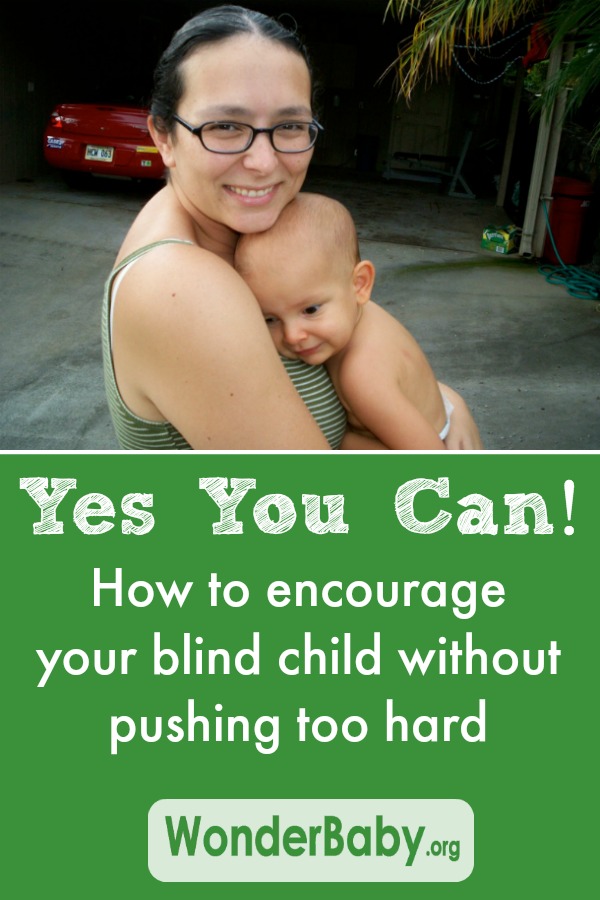Yes You Can! How to encourage your blind child without pushing too hard

“Devastated.”
I hear that word a lot. “When we first discovered our son was blind we were devastated…”
I understand that. I’ve experienced it myself. But it’s funny how, now over two years after the so-called devastation, it’s so hard to imagine that I ever felt that way. My son, Ivan, just seems so perfect and so full of potential and possibilities.
But there certainly was a time when all I could think about were all the things Ivan would not be able to do as a blind child. He’ll never blow bubbles, fly a kite, or watch Sesame Street. Probably because coloring was always a favorite activity for me as a child, I kept returning to the thought that he would never color in a coloring book. How could a blind child possibly have fun with colors?
Eventually I realized that I was really stuck in the world of can’t, so I began trying to think more positively. I started to say to myself, “Ivan can do anything he wants to do!” He can color, fly a kite, go to the movies, play sports, and whatever else he puts his mind to!
This is a much better attitude, but it also has a dangerous down side that I almost got caught up in. It’s hard to remember that it’s possible to be too positive. Not only will Ivan definitely face limitations, I also risked pushing him into activities just for the sake of proving that my blind child can do all that a sighted child can.
I suddenly pictured myself forcing Ivan to play soccer or color in that coloring book just because that’s what all the “normal” kids are doing. It made me shudder.
I didn’t want to foster the attitude that Ivan can do things simply because I desperately need him to. I see this with parents of blind children every day: They push their child to fit in or to participate in activities that don’t interest them simply for the benefit of the parent. I think it’s very important to remember:
Now I try to be more realistic in my expectations of Ivan. With coloring, for example, I still think that this is something Ivan can do, but now I think about how we can make the activity as entertaining and beneficial for him as possible.
Activities like coloring and painting are good for Ivan because they strengthen his hands, encourage grasp, and facilitate wrist rotation. They’re fun because there are more elements to coloring and painting than just the visual; crayons and paints, for example, have a distinct smell and feel.
Also, since Ivan is blind, we can experiment with different ways to make coloring and painting exciting for him: We can finger paint with pudding, then eat our art; we can draw with scented markers; we can place sandpaper under our drawing paper so that the crayon marks are raised; or we can make art with strings, buttons, curled lengths of paper, and other three-dimensional objects. Whatever we do, it will be beneficial because we will explore Ivan’s other senses while encouraging him to participate in those “normal” childhood activities. And most importantly, it will be fun because we’ll only do it if Ivan finds it enjoyable.
I do believe that Ivan can do almost anything and that nearly any activity presents some sort of learning opportunity. The only way Ivan will learn about the world is through interacting with it. Of course, Ivan may not be interested in art at all – he may be more of an action kind of guy, and that’s fine, too. We won’t discourage him from running or riding a bike any more than we would discourage him from playing with paints and crayons!
Remember that your child is a child first. Don’t think of your child as a blind or handicapped child. Their disability is an integral part of who they are but does not define who they are as a person. Some kids like to draw and others don’t; some kids like to run and others don’t. Let your child explore the world in their own unique way, encourage this exploration, but don’t push them into activities just because it will make you feel better about their disability!

Related Posts

Eye Conditions and Syndromes, Visual Impairment
Neuralink Announces Plans to Restore Sight to the Blind with Brain Chip
Elon Musk’s company Neuralink has announced plans to begin human trials of its new “Blindsight” brain chip by the end of 2025.

Visual Impairment
The Gift of Understanding: How a Young Child Helps His Blind Father Navigate Life
When a parent is blind, it’s natural for people to wonder how their sighted child will adapt. Will they struggle to understand their parent’s needs? Will they feel burdened by...

Braille and Literacy, Toys, Visual Impairment
24 Braille Toys for Kids Who are Blind
Everything from alphabet blocks to raised line coloring pages and activity books to puzzles to card and board games... and so much more! And it's all in braille ready for...